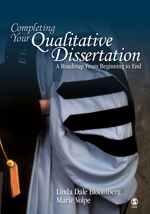Completing Your Qualitative Dissertation : A Roadmap from Beginning to End
The doctoral dissertation is academia’s Mount Everest—a massive undertaking, requiring discipline, stamina and emotional reserves. Thus, as Marie Volpe and Linda Dale Bloomberg, both faculty members in TC’s Adult Learning and Leadership Program and TC graduates, note in Completing Your Qualitative Dissertation: A Roadmap from Beginning to End, every university and college has a significant number of what are commonly referred to as All-But-Dissertation (ABD) students who dwell in the purgatory of the uncompleted thesis.
Volpe and Bloomberg focus on qualitative research methods, in part because there is a growing interest among academics in using them. In fact, when Volpe recently conducted 11 lectures in
The book is geared to doctoral students in the social sciences who are about to embark on the dissertation process or who are underway. It is, in effect, “a dissertation in action.” A real research problem is laid out in Chapter 1 and is carried through all subsequent chapters. To illustrate each step in the process, the authors identify the problem statement, develop the research purpose and research questions, formulate appropriate data collection methods, analyze and synthesize data, and present conclusions and recommendations. Carrying one research problem throughout the book’s three parts allows the reader to follow the same idea as it threads through the steps required to complete the research and write the dissertation.
Part One constitutes a broad introduction to the complex task of writing a dissertation, and offers an overview of the steps involved in preparing for the dissertation process. Included are discussions around becoming organized, identifying and developing a researchable topic, choosing an appropriate qualitative research tradition, selecting advisers, developing the proposal, guidelines for good writing and identifying resources.
Part Two provides comprehensive instructions on the content of each dissertation chapter, accompanied by illustrations of what a completed chapter should look like, using the specific research problem addressed in this book as an example.
Part Three addresses the final stages of the dissertation process, including checking alignment among key elements, selecting an appropriate title, assembling the manuscript, proofreading and editing, choosing a defense committee and preparing for a successful defense, and considering possible avenues for the presentation and publication of the work.
The book describes the different techniques employed by qualitative researchers (case study, ethnography, phenomenology, etc.) and guides the doctoral candidate through each chapter, from literature review to data collection and through to the defense. Throughout, the authors acknowledge that the challenges involved are both practical (How will I find appropriate data?) and ineffable (Am I committed enough to make this happen?)
Completing one’s dissertation, they write, is above all “a matter of tenacity, perseverance, and patience”—and the emotional armor to withstand the “sense of confusion and feelings of inadequacy, incompetence, and frustration” that can bedevil a writer mired in a fourth, fifth or never-ending draft.
Published Monday, Aug. 25, 2008
